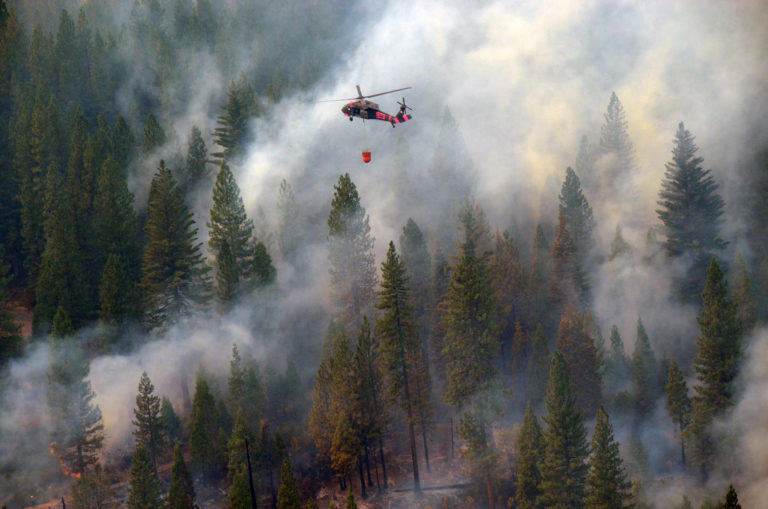Every year, thousands of fires engulf forests, grasslands and moors across Europe. In 2018, more than 204,861 hectares of land were left burnt in Europe and other countries around the Mediterranean, while the previous year wildfires destroyed over 1.2 million hectares. Blazes in the Arctic in June 2020 set a new record in carbon emissions in 18 years of monitoring.
As the trees, shrubs, grass and peat are engulfed by these fires, huge quantities of smoke, soot and other pollutants are released into the air. With large fires, the smoke can rise many kilometres into the stratosphere and spread across entire regions, causing air pollution in areas far away from where the flames are.
“In the eastern Mediterranean we get smoke that blows down from forest fires in Russia and when it happens there is just hazy smoke everywhere,” said Athanasios Nenes, an atmospheric chemist at the Institute of Chemical Engineering Sciences in Patras, Greece. “It can be quite dramatic. They are affecting air quality over entire regions or parts of continents.”
Nenes is the principal investigator of the PyroTRACH project, which is studying how emissions from wildfires change in the atmosphere and the impact this has on human health and climate.

Globally, wildfire smoke is estimated to cause over 339,000 premature deaths a year – far more than those who lose their lives directly in these blazes.
The PyroTRACH researchers are using a special environmental chamber in the laboratory that replicates the conditions found in the atmosphere. They then generate fresh smoke samples by burning different types of plant material, which are allowed to “age” in the chamber.
Over time Nenes and his team have been able to see how the chemistry of the particles in the smoke changes when exposed to the atmosphere, sunlight and darkness.
“We are trying to understand the lifetime of smoke in the atmosphere and how it chemically evolves,” said Nenes. “We want to characterise the impacts it will have on human health and the climate. Does it become more toxic (with age), or have a greater (warming) effect on the climate (than currently thought), or supply more nutrients to ecosystems when it falls back to the ground?”
One of the key findings the team has made since the five-year project began in 2017, is that particles released from burning vegetation in forest fires become more toxic over time.
While in the air the smoke particles chemically react with trace radicals – molecules with unpaired electrons – to undergo a process known as oxidation. This converts the compounds in the smoke particles into highly reactive compounds. When they are breathed in, these reactive compounds – known as free radicals – can damage cells and tissues in the body.
“We know that breathing in smoke when you are close to a fire is not good, but we have seen that over time it gets worse – up to four times more toxic a day down the road,” said Nenes, referring to some of their experiment results. “These results show smoke samples taken from the air more than five hours after they were released from a fire, were twice as toxic than when they were first released and as they aged further in the laboratory the toxicity increased to four times the original levels.”
‘People might not even be aware they are breathing in the fumes from a faraway forest fire, but it will be affecting their health.’
Reactive compounds from wildfire smoke are thought to have a number of short and long-term health effects, such as making people more prone to infections, bringing on breathing difficulties and leaving some people more prone to heart attacks.
“At the same time the smoke particles also contain carcinogens, which also oxidise and become more carcinogenic, increasing the risk of cancers,” said Nenes.
This increase in toxicity is a particular concern as smoke from large wildfires is known to travel across whole continents and even oceans. Smoke billowing from forest fires in Alberta, Canada, for example, was tracked as spreading down the east coast of the US, across the Atlantic and into Europe in 2019. Similarly, smoke from the recent devastating fires in Australia engulfed South America and pollution from wildfires in Siberia have spread to western Canada and the US.
This means that large wildfires can have dramatic impacts on the air quality and visibility in cities far away from the source of the smoke, which can then make urban air pollution worse, increasing the risk of health problems and deaths among those living there.
Nenes hopes that characterising the pollution from wildfires and domestic woodburning could help to improve climate change models as some of the soot released by fires – known as brown carbon – plays a considerable role in absorbing heat from the sun, and makes global warming worse.
Knowing how much of this brown carbon is produced in wildfires and domestic woodburning would allow climate scientists to make better predictions.
With climate models already showing that wildfires are likely to become more common and intense as global temperatures increase, the smoke they produce could pose an even greater risk to human health and the environment.